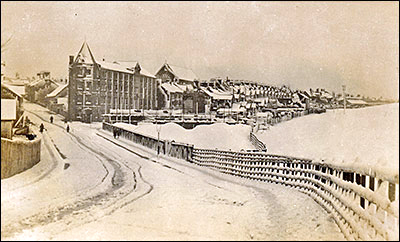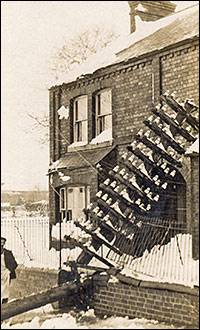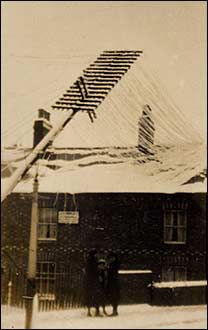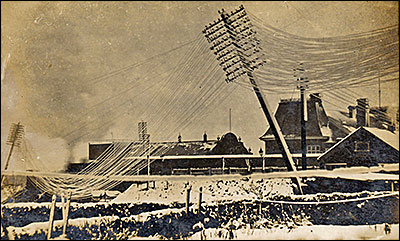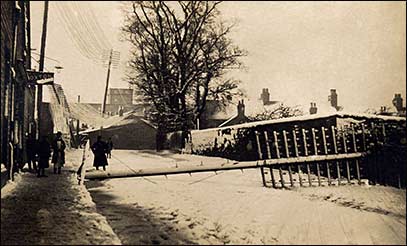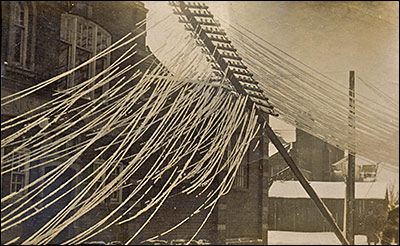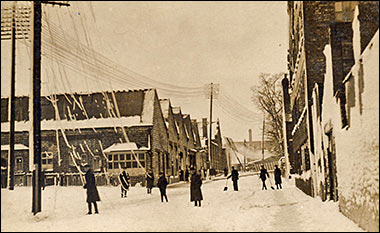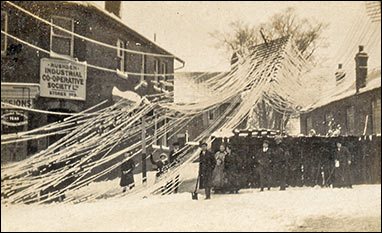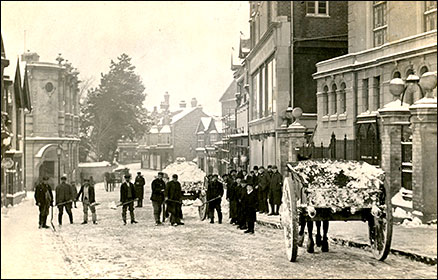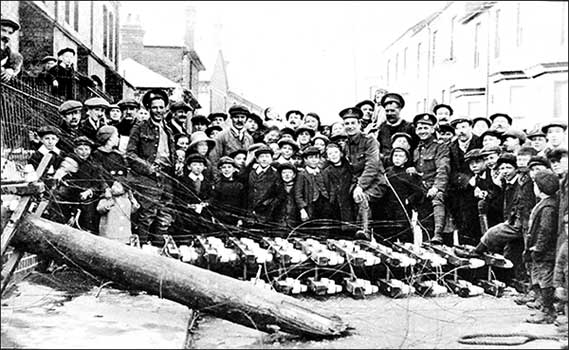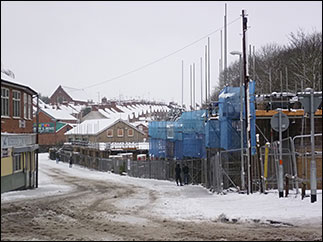|
|||||||||||||||||||||||||
| Article taken from the Rushden Echo 31st March 1916 transcribed by Jim Hollis |
|||||||||||||||||||||||||
|
THE 1916 BLIZZARD
|
|||||||||||||||||||||||||
|
APPALLING BLIZZARD IN THE MIDLANDS.
TERRIBLE DAMAGE IN NORTHAMPTONSHIRE AND BEDFORDSHIRE. PROPERTY BADLY INJURED IN RUSHDEN AND HIGHAM FERRERS DISTRICT. THE WORST STORM FOR FORTY YEARS. TOWN AND VILLAGES ISOLATED. HUNDREDS OF TELEGRAPH AND TELEPHONE POSTS BLOWN DOWN.
|
|||||||||||||||||||||||||
|
|
|||||||||||||||||||||||||
|
|||||||||||||||||||||||||
|
Scenes unparalleled in the history of Rushden were witnessed as the result of the disastrous blizzard that raged over the country at the beginning of the week, and some of the oldest residents of the town informed us that they can recollect no gales that caused such extensive damage as that which prevailed on Monday and Tuesday last. Fortunately, so far as we can ascertain, there has been no loss of life or bodily injury in the immediate locality, but dozens of trees have been uprooted and the damage to Government property is incalculable, scores of telegraph poles having been blown down, involving damage to hundreds of miles of wire. On Tuesday and Wednesday the Bedford-road presented an indescribable scene of devastation, and was absolutely impossible so far as vehicular traffic is concerned, not only by reason of the heavy snow drifts but also on account of the dozens of heavy telegraph poles that had been blown across the road. Looking right and left from the Rushden Isolation Hospital, as far as the eye could see, only two poles could be observed standing, and the fallen poles, together with masses of tangled wire obstructed the road, combined to make up a picture of confusion doubly confounded. Naturally telegraphic and telephonic communication was thoroughly disorganised, as was also the railway traffic, this resulting in considerable delay in the delivery of the mails and daily papers, not to mention inconvenience to would-be passengers.
Along the road leading from Higham Ferrers to Chelveston pedestrians who had the temerity to brave the rigours of the weather found the snow thigh deep, and an attempt to get through with a horse and trap had to be abandoned, as so deep was the snow that it covered the axle trees, and the horse was bleeding from the nose. It is little short of a miracle that so little damage was done to household property; nevertheless, considerable alarm was caused by several threatened calamities. At 2a.m. on Tuesday, Mr. J. H. Nunley, tailor, Orchard-place, Rushden, heard a loud report resembling the noise of an explosion and as he informed a representative of the “Rushden Echo,” thought the Zeppelins had come. Although his fears in that connection proved groundless, the experience was nearly as alarming, as an investigation showed that the wire hawser supporting the telegraph pole in Orchard-place has been pulled from the ground by the force of the gale, bringing with it a large ball of earth, and the pole itself was canting over at a dangerous angle towards Mr. Nunley’s house. At daybreak so alarming appeared the situation, that Mr. Nunley and his neighbours on either side — Mrs. Knight and Mrs. Linnitt — on the advice of the landlord, Mr. O.Claridge, vacated their houses, removing as much of their furniture as possible. They were kindly provided with temporary accommodation by their neighbours. During Tuesday afternoon’s gale the pole was noticed to be swaying about dangerously, and it was within two feet of the roof of Mr. Nunley’s house. it fell no further and on Wednesday morning it was found possible to raise it slightly and heavy timber support was put under it. A post opposite Messrs. E. Claridge and Sons’ factory was split from top to bottom, and struck the factory in its fall, but fortunately it was a glancing blow, and no damage was done to the building. The mass of twisted wires from these falling posts lay across Queen-street, until the wires had been cut and swept aside the thoroughfare was closed to vehicular traffic. A telegraph post opposite the factory of the Coxton Shoe Company was snapped off at the base and fell across the road, but again buildings opposite escaped damage as the head of the pole fell into a private roadway at the back of houses in Victoria-road. A house at the corner of Park-road and Mannings-lane had a miraculous escape from damage, a telegraph post opposite it being snapped clean in two by the force of the gale. The head of the pole bearing the wire struts was blown clean across the road, and fell on to the top of a bay window, but, strange to relate, no damage was done, not even a pane of glass being shattered, the force of the impact having been broken, we should imagine, by the railings and piece of raised garden in front of the house.
The dwelling house opposite the Victoria Hotel, occupied by Mr. Robert Marriott, builder and contractor, had a marvellous escape, as the telegraph post which stood in his front garden was snapped off like a twig, breaking into two pieces. This occurred between 2 and 3 a.m., on Tuesday. The top of the pole bearing the wire insulators was carried against the window of the top bedroom in which two little children were sleeping. The force of the impact shook the house, but fortunately the damage was confined to the carrying away of a foot or two of roof spouting. It is a wonder, however, that the front of the house was not smashed in. The telegraph post opposite the engine room of Messrs. B. Denton and Sons’ factory at Rushden snapped through at the base of the insulator arms, and this portion fell on to the gas generating shed, partially penetrating the zinc roof. Only one telephone line at Rushden, we believe, escaped damage - that of Mr. J. S. Clipson, Church-street. We understand that Mr. Collins, dairyman, Rushden, whose field and cowsheds are in Newton-road, got stuck up there with his milk-float until the Rushden Council employees arrived with the snowplough and managed to extricate him from his unenviable position. There were several horses and men at work clearing away the heavy drifts, and we are informed that the road to Newton turn could not possibly be cleared before today (Friday). Yelden residents desiring to get to Rushden, were compelled, much to their annoyance, to proceed thither via Chelveston, and even on this road the snow banks were from eight to ten feet in height. Considerable damage is reported from the Irchester district. In the village itself most of the telegraph wires were broken down, and several chimneys to which wire was attached were damaged by the weight. On the Chester-road the wires were practically all down and the posts were leaning over at a dangerous angle, moreover one tree was blown down, and so strong was the tempest that a large bough which had become entangled in a wire was carried the full length of the wire into a field, and part of the same bough was carried a full 30 yards further on. Three trees were blown down on the Knuston-road and along the railway line was one mass of wire entanglements and broken and slanting poles. The railway authorities at Irchester on Tuesday and Wednesday were unable either to collect or deliver goods. On Tuesday two soldiers who were desirous of travelling by the first up train, having been warned for foreign service, were unable to get away, and it is feared missed their boat. Windows have been broken and a glass house was demolished. Practically all the roads leading out of Rushden were blocked, and many people in the villages around were deprived of their supplies of bread and other commodities.
A Rushden firm of undertakers had made a coffin which had to be taken to Newton Bromshold, and they experienced the greatest difficulty in carrying out the order. The conveyance in which the coffin was being removed became wedged in the snow, and ultimately the coffin had to be carried to Newton, the journey taking about four hours. A motor car belonging to Mr. Harris, of Newton Bromshold, got stranded near Mr. Osborne’s house in the road between Newton and Rushden, near the Rushden Court Estate. Six men were busy trying to extricate it, but up to yesterday they had not succeeded. At Higham Ferrers several telegraph posts are down in the back-way and on the road leading to Irthlingborough L. and N.W. Station. Numerous trees have been uprooted but we have received no information of damage to household property, or of any local casualties, resulting from the great storm. THE BLIZZARD The one bright spot about Tuesday’s appalling blizzard is the fact that the loss of human life in the Midlands was only slight. The Rushden and Higham Ferrers district was in the very centre of the storm and bore the whole fury of the elements, but, while the damage to property was enormous, there was happily not a single fatality in the immediate neighbourhood, and the loss of life in Northamptonshire and Bedfordshire is not heavy. A woman named Rose Bradshaw, aged 54 years, supposed to be a native of Luton, was walking along the Newport Pagnell road towards Hardingstone Workhouse, and when about a hundred yards from the Workhouse, became so exhausted that she was unable to proceed. It is stated that she had walked from Wellingborough with another woman, named Annie Clarke, aged 68. The elder woman struggled on to the Workhouse and reported the matter. A stretcher was procured, and the exhausted woman was brought into shelter, but in spite of efforts to get her round, she passed away about a quarter of an hour later. The fall of snow was terrible. It was, perhaps, the heaviest fall of snow since January 18, 1881, when the drifts were tremendous. For the time of the year, the nearest comparison is the great snowstorm of Good Friday, 1876, when on some high roads the drifts were 15 feet deep, covering fingerposts and hedges, and in some places leaving the trees as the only indication of road routes. It is said that this week the snow drifts in some places were 20 feet deep. Rushden and Higham Ferrers usually escape the worst storms, but this time the district had a visitation never to be forgotten. It is, in fact, stated by engine drivers that the snow was worse on the Midland Railway between Bedford, Wellingborough, and Kettering than anywhere else on the system. It is estimated that over a million tons of snow fell on Tuesday in the borough of Northampton. We quite believe there has been nothing like it for forty years, and we hope there will be nothing like it again for considerably more than twice forty years. Rushden’s Snow Plough At the time of the snow fall in February Mr. W. B. Madin, Surveyor for the Rushden Urban District Council, improvised a snow plough at very short notice for the roads. The making of the plough was not commenced until half-past nine one morning, and by half-past one it was doing excellent work in clearing the snow from the centre of the roads. The sides of the plough, however, after it had served its purpose, were found to have been worn away to a depth of five inches, and it had to be abandoned. Mr. Madin has now had a better one made, and its value has been amply demonstrated this week. It was made entirely in the Urban Council’s yard by the Council employees, and the cost was only about £3. It is made with eleven-inch red deal sides, three inches thick, jointed at a fairly acute angle, and is well braced and bolted together. It is shod with steel plate, and the “nose” is weighted to keep the plough down. The handle for steering is formed of an old cart shaft. Three horses are required to pull the plough, and one man to steer it, and it is made after the style of snow-ploughs which Mr. Madin has seen in use in Derbyshire. On Tuesday morning about six or seven miles of Rushden streets were cleared of snow, but in the blizzard of the afternoon it was impossible to go out, the horses being “blown”. On Wednesday and yesterday the side streets were cleared, and Mr. Madin’s scheme, which has made vehicular traffic a possibility, has also made the journeys to and from the factories a much safer thing for the workpeople.
Editor's note: To read J. Enos Smith's memories of this blizzard, click here. More about the Blizzard in the whole district
|
|||||||||||||||||||||||||
|
|
|||||||||||||||||||||||||
